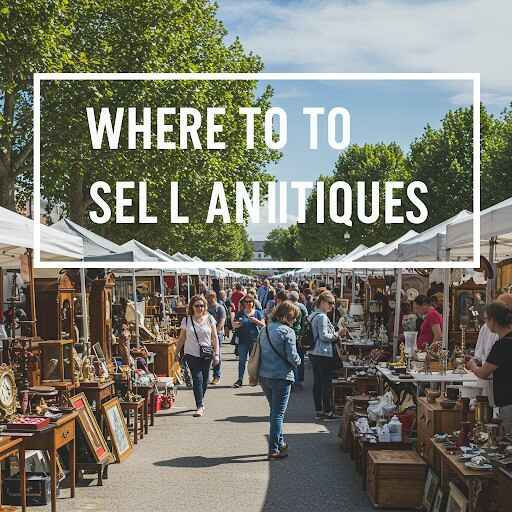If you’re wondering, “Where to sell antiques near me?”, you’re not alone. Whether you’ve inherited heirlooms, stumbled upon vintage treasures, or are downsizing, finding the right place to sell antiques can be both rewarding and challenging. This guide will help you navigate local and online options to get the best value for your items.
Understanding What Qualifies as an Antique
Before selling, it’s crucial to determine if your item is genuinely antique. Antiques are typically defined as items that are over 100 years old. Vintage items are between 20 to 100 years old, and collectibles may not be old at all but are valued for their rarity or uniqueness.
Common categories include antique furniture like Victorian chairs and oak tables, vintage and estate jewelry, original artwork such as oil paintings and lithographs, rare coins and currency, and fine ceramics and porcelain like Ming vases or Delftware.
| Category | Examples |
|---|---|
| Furniture | Victorian chairs, oak tables |
| Jewelry | Art Deco rings, vintage brooches |
| Art | Oil paintings, lithographs |
| Coins & Currency | Pre-1900 coins, old banknotes |
| Ceramics & Porcelain | Ming vases, Delftware |
Preparing Your Antiques for Sale
To maximize your profit, it’s important to have your items appraised by a professional. This gives you a clear idea of what they’re worth in the current market. Authentication documents can further support your asking price.
Cleaning is also essential but should be done carefully to avoid damaging the item. Avoid over-restoration, as the original condition often retains more value. Take clear, high-resolution photos from multiple angles, and write detailed descriptions including materials, size, age, markings, and provenance.
Local Options: Where to Sell Antiques Near Me
Selling Through Antique Shops
Local antique shops are among the most reliable options if you are looking for where to sell antiques near me. These shops usually have a curated inventory and are always on the lookout for unique pieces that match their style and clientele. If your item fits their niche, you can often get a fair price on the spot. However, shop owners typically offer less than retail value, since they need to make a profit on resale.
Using Consignment Stores
Consignment stores allow you to display your antiques in their shop, but you get paid only once the item is sold. These stores generally take a commission, which can range between 20% and 50% depending on the value and nature of the item. Though this method might take more time, it can fetch higher prices compared to instant sales.
| Store Type | Commission Range |
|---|---|
| High-end boutiques | 30% – 50% |
| General consignment | 20% – 40% |
Estate Sales Services
Hiring a professional estate sale company can be ideal if you have a house full of antiques or an entire collection to liquidate. They take care of everything, including organizing, pricing, and marketing the event. Estate sales draw a large number of buyers and can sell multiple pieces in a short period, though you’ll pay service fees for the convenience.
Flea Markets and Antique Fairs
Flea markets and antique fairs are good places to connect with antique enthusiasts directly. These venues usually charge a fee for renting a booth. You will need to dedicate time to setting up and managing your booth, but you get the opportunity to interact with buyers who are genuinely interested in antiques.
Pawn Shops for Immediate Cash
Pawn shops are an option if you are looking for a quick sale. However, they usually offer the lowest prices due to the need to resell your item at a profit. Pawn shops may not have specialized knowledge in antiques, which can impact the offer.
Online Platforms for Antique Sales
eBay for Global Exposure
eBay is one of the most widely used online marketplaces for selling antiques. It gives you access to a global audience and offers options to list items as auctions or fixed-price listings. While there are seller fees and shipping responsibilities, eBay allows you to reach serious collectors worldwide.
Etsy for Vintage and Handmade Items
Etsy specializes in vintage, handmade, and unique items. If your antiques are at least 20 years old and visually appealing, Etsy can be a great platform. It is user-friendly and attracts buyers looking for specific vintage pieces, although competition is fierce.
Ruby Lane for Curated Antiques
Ruby Lane is a high-end platform focused exclusively on antiques and vintage items. The listing process is selective, and sellers must meet quality standards. Monthly fees and commissions apply, but the buyers on Ruby Lane are often collectors with a high willingness to pay.
Facebook Marketplace for Local Sales
For local sales, Facebook Marketplace is a convenient option. You can list your antiques without any fees and reach local buyers who prefer picking items up directly. Since you handle everything yourself, it’s crucial to meet in safe, public locations.
Craigslist for Quick Local Deals
Craigslist is another option for local selling. The listings are free and setup is quick. However, the platform comes with safety risks and scams, so always proceed with caution and arrange safe meeting spots.
Tips for Maximizing Your Antique Sales
The first step is to research similar items and their current market values. You can check completed eBay listings or auction house results to get an idea. Presenting your items well with professional-level photos and honest, detailed descriptions can greatly enhance their perceived value.
Pricing should be competitive but flexible. You may need to adjust based on buyer feedback or if the item doesn’t sell within a reasonable time. Being open to negotiation is helpful, especially in face-to-face selling situations.
Using multiple platforms simultaneously can also increase visibility. For example, list your item on Facebook Marketplace, eBay, and in a local consignment shop. This diversifies your chances of getting a better offer.
Avoiding Common Pitfalls When Selling Antiques
One of the most frequent mistakes is overpricing. Setting a price too high without justification can turn off potential buyers. It’s better to aim for fair market value based on condition, rarity, and demand.
Poor descriptions and bad photography can also deter serious buyers. Invest some time in writing a thorough description and taking clear, well-lit photos. Mention any flaws or signs of aging openly, as transparency builds trust.
Don’t ignore the impact of fees. Online platforms usually charge for listings, final value, or payment processing. Include these costs in your pricing strategy to avoid undercutting your profits.
Safety is also important, particularly when meeting strangers for local sales. Always meet in public places, and consider bringing someone with you. Avoid inviting buyers to your home unless necessary and safe.
Conclusion
Selling antiques can be a highly rewarding endeavor if you know where and how to do it right. Whether you choose to go through a local antique shop, a consignment store, an online platform like eBay, or an estate sale company, each route has its own benefits and drawbacks.
If you’re asking yourself, “Where to sell antiques near me?” you now have several reliable answers. Local shops, fairs, and marketplaces can give you quick access to buyers, while online platforms can expose your items to a global audience. By understanding your antiques, preparing them for sale, and choosing the right venue, you’ll increase your chances of a profitable and smooth selling experience.
In 2025, the antique market is more active than ever. With the right knowledge and approach, you can turn your valuable items into meaningful earnings. Always do your research, present your items well, and choose the method that suits your goals best.












